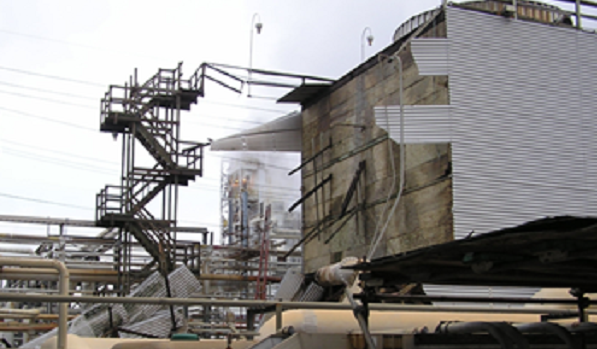
Cooling Tower Maintenance, and Why You Should Invest
Performing routine condition assessments of industrial cooling towers is recommended by the Cooling Technology Institute (CTI) as a cost-effective means of sustaining cooling reliability. Most owners recognize the need for maintaining cooling towers and are aware of previous collapses in the industry. However, because cooling towers do not generate product, inspection and maintenance of these structures is often neglected as funding is directed towards more profitable units.
Timber mechanical draft cooling towers face unique deterioration mechanisms as opposed to other materials typically utilized in industrial environments. Timber members are susceptible to rot if treatment systems are incorrectly applied. Shown below is an example of iron rot around carbon steel bolt connections:
Large fans at the top of the cooling tower can impose significant vibrations if not properly balanced. Vibrations can lead to fatigue failures, connection loosening, and eventual stability loss. The warm, moist atmosphere of the cooling tower interior also presents challenges. Although wood can maintain structural integrity for many years while remaining fully submerged, wetting/drying cycles can accelerate degradation and lead to failures, particularly near the top of the cooling tower. Shown below is an upper vertical bracing connection that was compromised, and a failed wooden ladder rung:
Wind and Weather Considerations
Another significant safety issue can result from shroud failure during high wind events. Shrouds containing fans are effectively large wind sails located 40 to 60 feet above grade. Over time, connections along seams and bolts anchoring shrouds to the tower can loosen and portions or all of the shroud can fail and fall to grade.
Non-biased Cooling Tower Inspections
Most companies performing field evaluations of cooling towers are construction contractors that also perform repair work. After all, they are most familiar with safety requirements, access methods, and tower configurations. However, this approach results in a conflict of interest as repair scopes are determined by the party responsible for completing the work. Impartial evaluation of cooling towers from the owner’s perspective should be performed to maximize reliability without performing unnecessary repairs.
Summary
In conclusion, ongoing maintenance and inspection of cooling towers in industrial facilities is recommended by CTI and critical for maintaining reliable cooling water systems. Inspections should be performed from the owner’s perspective to ensure that repair scopes are impartially developed. By observing potential structural and mechanical deficiencies early in the deterioration process, plans can be developed to effectively address these defects and prevent unplanned outages. Because cooling towers typically service multiple units, a collapse could bring down a significant portion of the facility. In this scenario, cost of repair is not only higher, but could result in significant additional costs associated with lost production time.
– Nick Triandafilou, Brindley Engineering Structural Department Manager, email: ntriandafilou@brindleyengineering.com
- Read Part 1: Industrial Cooling Tower Maintenance
- Read Part 2: Industrial Cooling Tower Inspections
- Read Part 3: Cooling Tower Structural Analysis
- Read Part 4: Cooling Tower Repair Plan
- Read Part 5: Cooling Tower Preventative Maintenance
